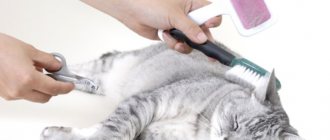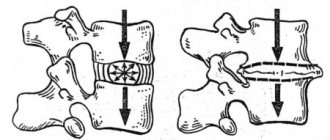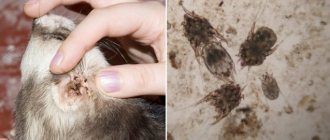Among the diseases that cats suffer from, a significant proportion are those caused by various parasites. One of the most common diseases in this group is demodicosis. The causative agent of demodicosis in cats is the subcutaneous mite. This parasite can cause a lot of anxiety and problems for your mustachioed pet. The Murkoshi team will talk about what it is, how the disease progresses and how to remove this parasite in this article.
1) Pathogens of demodicosis and methods of infection 2) Risk groups 3) Types of demodicosis 4) Symptoms of subcutaneous mites 5) Treatment of a localized form 6) Treatment of a generalized form 7) Prevention of demodicosis
Features of the subcutaneous mite
In cats, demodicosis is often diagnosed. The causative agent of this dermatological disease is the demodex subcutaneous mite. The insect belongs to the arthropod family; there are two types of parasites: gatoi and cati.
Mites reproduce in the glands that produce saliva, sweat and in the roots of hairs. The female lays oocytes, from which larvae appear after 4-6 days. In order to turn into adults capable of reproduction, they need from 7 to 10 days. Microorganisms form colonies, which can be identified by small bumps on the animal's skin. Large accumulations of mites lead to dysfunction of the skin and atrophy of the sebaceous glands.
Demodicosis can be localized or generalized. In the localized form, individual areas are affected: the neck and chin, eyes, ears. Generalized demodicosis spreads throughout the body. The risk group for this type of disease includes representatives of the Burmese and Siamese breeds.
How to diagnose demodicosis correctly?
Only a veterinary specialist will be able to correctly assess the damage to your pet’s skin and suggest that you undergo the necessary examination.
Important:
● collect anamnestic data about the sick cat; ● conduct a clinical examination of her; ● examine a scraping of the affected area of skin microscopically for the presence of mites at different stages of its development.
If a Demodex mite is suspected, a skin scraping should be taken before the appearance of ichor (from an intact area of skin). Since the mite penetrates deeply into the skin of the animal, only a scraping test of all layers of skin from different lesions will be informative. A superficial scraping will be false negative.
Causes of the disease
Subcutaneous mites can live in a cat’s body for many years. The natural defense system restrains its reproduction, the disease does not manifest itself in any way. The tick feeds on dead cells of the epithelial layer. When a cat’s body is weakened, immunity is reduced, microorganisms begin to multiply quickly, and demodicosis appears. The reasons for this phenomenon may be:
- chronic diseases;
- worms;
- non-compliance with care rules;
- poor quality nutrition that does not provide the supply of necessary minerals and vitamins;
- lack of preventive antiparasitic measures.
Stress can also weaken an animal’s natural defense system.
Is it possible to get infected from a person?
The Demodex mite affects not only animals, but also people. However, these are completely different types of parasite. As has already become clear, infection from an animal is not dangerous. But transmission from person to person is possible.
Routes of infection from humans:
- direct contact;
- cloth;
- bed sheets;
- facial cleansing in the salon.
According to statistics, 90-92% of the population are carriers of the subcutaneous mite. But demodicosis manifests its symptoms only in certain cases: weakened immunity, frequent stress, pregnancy, metabolic disorders.
An exacerbation of the disease is often observed in the autumn season. The reason for this is the experience of hot summer days, when the skin often sweats and becomes oilier. In addition, summer heat, or rather ultraviolet radiation, can significantly weaken the immune system.
Methods of infection with subcutaneous mites
There are several ways of infection with an arthropod parasite:
- transmission of the parasite through direct contact with a carrier;
- indirect contact with the belongings of an infected individual, subcutaneous ticks can get onto a cat from the bedding of an animal that has these diseases, or from a hair brush. A person can carry these microorganisms on clothing if he has had contact with an infected animal.
- intrauterine infection.
Owners of several cats and breeders need to simultaneously treat all pets when the disease is detected.
Signs and symptoms of the lesion
The main areas of dislocation of the subcutaneous mite are considered to be the muzzle and the front part of the body of the pet. The parasite can live on the body of a new victim for quite a long time without symptoms. The first signs of damage will appear when the pet’s immunity decreases.
At this point, the owners begin to note:
- deterioration of the exterior;
- the appearance of keratinization areas in the eye area;
- impaired skin pigmentation;
- the appearance of dandruff over the entire area covered with hair;
- hair loss in clumps.
Sometimes pets develop acne and severe itching occurs in certain areas of the skin. The cat begins to scratch constantly, which leads to the formation of a blood crust. The height of the crust covering the wound can reach 12 mm. At the top of the growth there remains a small hole from which a stream of ichor continuously oozes. Areas of the skin with alopecia become covered with small ulcers, and the skin acquires a silvery tint.
The symptoms listed above occur because under the skin of a pet the tick digs passages along which it constantly moves. The products of its vital activity remain here. To examine the subcutaneous tick on the body of a four-legged pet, you do not need to make superhuman efforts. If you take a bald area of skin and make a fold out of it, you will even be able to remove the parasite yourself.
After examining the insect, it should be placed in an airtight container and transported to the veterinary clinic along with the injured cat. A specialist will be able to conduct a thorough diagnosis and outline an algorithm for the owner’s subsequent actions, which will help return the animal to a full life.
Pets at risk
No cat breed is immune from demodicosis. Infection with arthropod parasites is not dangerous for a healthy animal. Strong immunity will prevent it from reproducing. However, those at risk include:
- kittens separated from a cat early;
- pets after surgery;
- cats exhausted by prolonged starvation;
- animals with various diseases: rickets, toxoplasmosis, diabetes, leukemia, etc.
The development of the disease can be triggered by stress associated with a change of place of residence or constant visits to the pet groomer.
Prevention of demodicosis in cats
The skin mite is a conditionally dangerous parasite. Usually they are present on the animal’s body, but in minimal quantities. Normally, they cleanse the skin of dead particles. However, when the body's defenses decrease, the number of ticks increases sharply, and then the disease develops.
Thus, prevention should include strengthening the animal’s own defenses. Cat owners must feed it properly and provide adequate living conditions. For animals that are predisposed to the disease, it is useful to administer Immunoparasitan once every six months.
Periodically, the cat needs to be treated with flea medications and given anti-worm medication. During walks, it is important to ensure that the cat does not come into contact with stray animals.
Even if the symptoms of the disease have disappeared, treatment should not be stopped prematurely. To confirm recovery, an additional examination of the scraping is carried out.
Symptoms of the disease
The rapid growth of subcutaneous mite colonies causes itching in the animal. Active hair loss is observed, and bald patches with an oval outline are formed. In these areas, the skin becomes reddish and ulcers appear. Infectious abnormalities appear as secondary signs. In most cases, subcutaneous mites are localized on the front legs, near the eyes, on the neck, and chin.
The main signs of demodicosis are:
- hair loss;
- swelling, redness of the skin;
- ulcers and pustules;
- decreased appetite;
- weight loss;
- severe itching;
- unpleasant odor;
- unkempt look.
The generalized form, developing, can lead to blood poisoning.
Pathogens
Depending on the type of pathogen, there are several diseases caused by ticks.
- Demodectic mange . The causative agent is a subcutaneous mite in a cat of the genus Demodex Canis. The mite is a normal representative of the cat's skin fauna; the disease develops in the presence of stressful situations and depletion of the body's immune reserves as a result of serious illnesses. The pathogen is safe for humans.
- Sarcoptic mange . The causative agent of the disease is scabies. The disease most often affects dogs and people; cat owners encounter it much less often. At the sites where the parasite has invaded, the formation of bald, itchy patches of skin is immediately observed. The most commonly affected areas are the muzzle, behind the ears and on the abdomen.
- Notoedrosis . This disease is considered true chastisement. The parasite multiplies in the thickness of the skin with tremendous speed, causing severe itching, as a result of which the animal constantly itches and tears the affected areas until they bleed. Scabies mites in cats are dangerous to humans.
- Infections with ixodid ticks . The parasite is a macroscopic blood-sucking insect that constantly lives in forests and parks. A tick may appear on a cat after the animal has walked in an area where parasites are common.
Treatment of demodicosis
The cat can recover on its own, without therapeutic treatment. But this is only possible with a localized form of the disease, if the pet’s body is strong and has a strong defense system. In any case, if signs of illness are detected, it is necessary to contact a veterinary hospital.
When treating demodicosis in an uncomplicated form, local therapy is used. Can be used:
- Shampoos containing antiseptic components to remove dead epithelial cells and waste products of microorganisms.
- Mitaban solution for treating affected areas. For the treatment of localized demodicosis, a composition with a concentration of 0.25% is used. For a generalized disease without complications, a solution containing 0.5% of the active component is used. If staphylocosis or pyodemocosis has developed against the background of demodicosis, you need a product with a concentration of 1%.
- Advocate drops are used in treatment and prevention. The product is applied with a pipette to places inaccessible to the cat.
- Preparations containing amitraz, pyrethrin for treating affected areas.
- Demodex gel, Saphroderm and sulfuric ointments to eliminate foci of inflammation.
Only a veterinarian should select products, dosages, and regimens of use. Exceeding concentrations can cause harm to the cat’s body.
Diagnosis of demodicosis in pets
Demodicosis has similar symptoms to many other diseases (for example, lichen), so when making an independent diagnosis, the likelihood of making a mistake is very high. The help of a veterinarian in this situation is mandatory.
To detect subcutaneous mites and confirm their assumptions, a specialist will take a scraping for analysis. The biomaterial is collected at the border between healthy and disease-affected areas. It is recommended to do this in the clinic laboratory. This will increase the chances of obtaining a reliable result.
The doctor carries out scarification with a scalpel. At the same time, it necessarily captures deep layers. The biomaterial is transferred to glass, treated with a solution and examined under a microscope.
If a cat has been confirmed to have demodicosis, the owner must clean the house and wash the animal’s rug. It is important to maintain a clean environment throughout the course of therapy.
Complex treatment of complex forms
If generalized demodicosis or a localized form with complications is diagnosed, then complex therapy is required, including:
- applying Amitraz oil solution;
- oral administration of Doramectin;
- distribution of Ivermec spray on the affected areas;
- parenteral administration of antiparasitic drugs;
- use of antibacterial agents.
At the same time, it is necessary to strengthen the cat’s immunity, for which the biogenic preparations Baksin and Gamavit are used.
Prevention of infection
Due to the fact that there are no vaccinations that could protect a cat from these parasites, it is important to follow some preventive measures to minimize the likelihood of such mites becoming more active and causing serious diseases.
A set of such measures include:
- Prevent your pet from contacting other animals if their health condition can cause even the slightest fear and suspicion.
- Carry out a periodic visual inspection of your pet. At the slightest sign of damage, immediately contact a veterinarian, since in the early stages it is much easier to get rid of the disease.
- During potentially dangerous periods, use various means for preventive treatment of fur or anti-parasitic collars for cats.
- Monitor the living conditions of the pet, compliance with sanitary standards, as well as the quality and balance of nutrition.
- After treating a cat for demodicosis or other similar diseases, it is necessary to disinfect the premises, as well as dispose of or thoroughly treat with special means care items or objects with which the infected pet had contact.
Treatment with folk remedies
In addition to medications prescribed by a doctor, you can use folk remedies to increase the effectiveness of treatment. Treatment of affected areas and wounds can be carried out:
- Ready-made tincture of calendula flowers, purchased at a pharmacy.
- A tincture prepared from the dry herb of tanning mackerel. A spoon of the product is filled with 500 ml of boiling water. After cooling, strain, dilute with 500 ml of cat bathing water.
- Concentrated decoction of chamomile.
Kerosene cannot be used for processing. It causes severe intoxication.
Drugs
All medications for subcutaneous mites in cats are selected exclusively by a doctor. The list of funds below is for reference only.
| Category | Drug name | additional information |
| Preparations for injections | Infermectin Otodectin Ivermec Novomec | Dosage – 1 ml per 10 kg of weight. The injection is given once a week. Minimum course – 2 weeks. It is administered subcutaneously or intramuscularly. The first method is considered more effective. Control is carried out by scrapings. |
| Dectomax Meradoc | 0.5 ml per medium-sized cat. Repeated injection after 10 days. Lasts for a long time. Has no side effects. | |
| Aversect | 0.1 ml every 5-7 days until recovery. Inserted into the withers or knee fold. | |
| Drugs that increase the resistance of immunity to parasites (immunomodulators) | Immunoparasite Maksidin Gala-vet Gamavit Ribotan | Immunoparasitan is the only drug of its kind that increases the body's resistance specifically against demodex. |
| Acaricidal ointments/gels | Ivermek-gel Amidel gel Neo Aversectin ointment | Treat the affected areas and adjacent areas to a depth of 2 cm. |
| Solutions | Neostomazan Butox Mycodemocid Amit forte Tsipam | The medicine is diluted with water. Use strictly according to instructions. |
| Sprays | Acaromectin Ivermec | |
| Drops on the withers | Stronghold Lawyer | Course – 2-4 months |
| Shampoos | Doctor Elite | Needed to clean the skin of a sick animal. |
| Anti-inflammatory drugs (external) | Ointment Pikhtoin Sea buckthorn oil Saphroderm gel | Used to soften and remove crusts. You cannot peel off the crusts yourself. Demodex begins to multiply with a vengeance, since the secreted sputum (ichor) is its main food. |
| Hepaprotectors | Essentiale Hepatovet Heptral | Any injections with an acaricidal focus place a large load on the liver. Therefore, hepaprotectors are necessary in complex therapy. |
| Nutritional supplements | Sulfur for animals | Administered with food once a day. Dosage 0.04 g. (about the size of a pea). Duration of treatment – 1 month. |
| Vitamins | Aevit Tetravit | To speed up skin recovery. They are given in the form of tablets or injections. |
Preventive measures
The main prevention of this disease is to maintain a strong immune system in a cat with a complete, balanced diet and proper care. It is also necessary:
- treat the tray, bedding, and bowls with disinfectants every week;
- regularly use sprays and tablets with antiparasitic properties;
- Put your pet on a collar treated with anti-parasite agents.
If a cat has suffered from generalized demodicosis, it must be sterilized.
How to cure a cat for Demodex mites?
Treatment of demodicosis consists of eliminating the tick and eliminating associated symptoms.
Only a veterinarian should select and prescribe medications for a sick pet depending on the course of the disease.
First of all, it is necessary to remove all predisposing factors and not use hormonal drugs. During treatment, control skin scrapings should be examined for the presence of mites every three weeks. Treatment of a sick pet can be stopped only after 3 negative results of control scrapings.
For treatment use:
- Antiparasitic drugs (ivermectins).
- Drugs that increase the biological activity of the body (immunomodulators).
- Anti-inflammatory and antipruritic drugs for external use (ointments, gels, sprays, oils).
- Antibacterial drugs (in case of secondary bacterial infection).
- Bathing using special shampoos (to cleanse the skin).
During the treatment period, the cat's owner must provide it with adequate feeding, follow the rules of maintenance and care (carry out disinfection treatment).
Preventive actions.
I. Carry out timely preventive antiparasitic treatment (from fleas and ticks). II. Avoid contact between a healthy pet and a cat infected with demodicosis. III. Contact a veterinary clinic promptly when the first signs of subcutaneous tick infection appear. IV. It is imperative to treat premises, cages and other places where infected animals are located with acaricidal preparations. V. It is recommended to dispose of items and bedding from a sick animal.
If a cat has suffered a generalized form of demodicosis, it is recommended to sterilize it to avoid further spread of the disease.
It is important to know! Cats that have recovered from the disease do not develop immunity against demodicosis. It is necessary to closely monitor the health of your pet and treat it correctly.
This type of tick is not dangerous to humans.
Causes and routes of infection
Demodectic mange in pets can develop under the influence of the following sources:
- worms and intoxication caused by waste products of these parasites;
- weakened immune system;
- improper and unbalanced diet;
- lack of vitamins A, E and B;
- keeping your pet in damp, dirty conditions.
Demodectic mange can be transmitted through contact between a cat and another infected animal or from the mother to a kitten. In some situations, the baby may be infected during intrauterine development. The length of the incubation period depends on the state of the animal's immune system.











